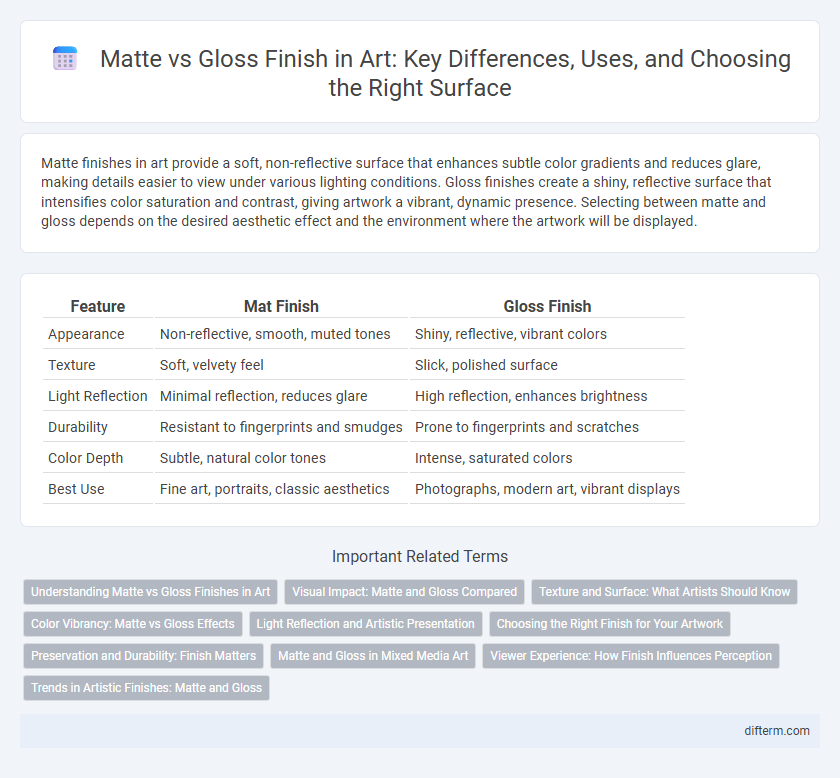Matte finishes in art provide a soft, non-reflective surface that enhances subtle color gradients and reduces glare, making details easier to view under various lighting conditions. Gloss finishes create a shiny, reflective surface that intensifies color saturation and contrast, giving artwork a vibrant, dynamic presence. Selecting between matte and gloss depends on the desired aesthetic effect and the environment where the artwork will be displayed.
Table of Comparison
| Feature | Mat Finish | Gloss Finish |
|---|---|---|
| Appearance | Non-reflective, smooth, muted tones | Shiny, reflective, vibrant colors |
| Texture | Soft, velvety feel | Slick, polished surface |
| Light Reflection | Minimal reflection, reduces glare | High reflection, enhances brightness |
| Durability | Resistant to fingerprints and smudges | Prone to fingerprints and scratches |
| Color Depth | Subtle, natural color tones | Intense, saturated colors |
| Best Use | Fine art, portraits, classic aesthetics | Photographs, modern art, vibrant displays |
Understanding Matte vs Gloss Finishes in Art
Matte and gloss finishes significantly affect the visual impact and texture in artworks. Matte finishes absorb light, reducing reflections and enhancing detail visibility, ideal for fine art prints and paintings with intricate textures. Gloss finishes reflect light, intensifying colors and providing a vibrant, polished appearance often preferred for photography and modern digital artworks.
Visual Impact: Matte and Gloss Compared
Matte surfaces diffuse light, creating a soft, understated visual impact that minimizes glare and enhances texture detail in artwork. Gloss finishes reflect more light, producing vibrant colors and sharp contrasts that make images appear more vivid and dynamic. Choosing between matte and gloss depends on the desired emphasis on subtleties versus brightness and boldness in the artwork's presentation.
Texture and Surface: What Artists Should Know
Matte surfaces diffuse light evenly, creating a soft, non-reflective texture that minimizes glare and highlights brushstrokes, making them ideal for detailed, textured artwork. Gloss finishes amplify colors and contrast by reflecting light, offering a smooth, shiny surface that enhances vibrancy but can reveal imperfections. Artists should consider the desired visual impact and viewing environment when choosing between matte and gloss to optimize texture and surface presentation.
Color Vibrancy: Matte vs Gloss Effects
Matte finishes diffuse light, resulting in softer, muted color vibrancy that reduces glare and minimizes reflections, which can enhance detail perception in art pieces. Gloss finishes amplify color saturation and brightness by reflecting more light, making colors appear more vivid and intense. Artists often choose matte for subtle, understated effects and gloss for striking, eye-catching visuals that emphasize contrast and depth.
Light Reflection and Artistic Presentation
Matte surfaces absorb more light, resulting in a soft, non-reflective finish that minimizes glare and enhances fine details in artwork. Glossy finishes reflect light sharply, creating vibrant colors and heightened contrast that amplify visual impact but may cause distracting reflections. Choosing between matte and gloss depends on the desired interplay of light, texture, and viewer experience in the artistic presentation.
Choosing the Right Finish for Your Artwork
Selecting the right finish for your artwork hinges on the desired visual impact and preservation needs. Matte finishes reduce glare and enhance subtle textures, making them ideal for detailed or muted pieces, while glossy finishes amplify color vibrancy and contrast, perfect for bold, dynamic works. Consider environmental factors and display conditions to ensure your artwork's longevity and optimal presentation.
Preservation and Durability: Finish Matters
Matte finishes excel in preserving artwork by minimizing glare and masking fingerprints, which helps maintain the piece's original appearance over time. Glossy finishes enhance color vibrancy and depth but are more prone to scratches and visible smudges, potentially requiring more frequent cleaning and care. Selecting the appropriate finish impacts the durability and long-term preservation of art, balancing visual appeal with practical protection.
Matte and Gloss in Mixed Media Art
Matte and gloss finishes play crucial roles in mixed media art, affecting texture, light reflection, and viewer perception. Matte surfaces absorb light, reducing glare and enhancing depth in layered compositions, while gloss finishes create vibrant highlights and intensify color saturation. Artists strategically combine matte and gloss elements to achieve dynamic contrast and emphasize focal points within mixed media artworks.
Viewer Experience: How Finish Influences Perception
Matte finishes diffuse light, reducing glare and enhancing detail visibility, which creates a softer, more subdued viewer experience. Glossy finishes reflect light intensely, amplifying colors and contrasts, resulting in a vibrant and dynamic perception of the artwork. The choice of finish directly impacts how viewers emotionally engage with the piece, influencing mood and interpretative depth.
Trends in Artistic Finishes: Matte and Gloss
Matte finishes in contemporary art emphasize texture and depth, absorbing light to create a subtle, sophisticated effect that complements intricate brushwork. Glossy finishes reflect light, enhancing color vibrancy and adding a dynamic, polished appearance favored in modern mixed media and resin art. Current trends highlight the strategic use of matte and gloss combinations within single pieces to balance contrast and visual interest, driving innovative expressions in artistic finishes.
Mat vs Gloss Infographic

 difterm.com
difterm.com